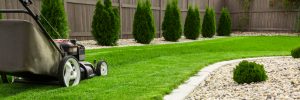Think of winter as your off-season in your annual landscaping game plan. With the right steps, you can prepare your lawn for the coming cold weather months and create a landscape that will add beauty to your home in the coming spring.
Aerate now
Q: When should I aerate and how often?
A: We recommend aerating twice a year in both Spring ( Mar – May ) and Fall ( Aug- Nov ) for most grass types. At a minimum aeration should be done at least once a year.
Q: What do I do after I aerate?
A: There are a few things you can do right after aerating like fertilizing, overseeding, and watering. What you decide depends on your personal preference and the condition of your yard. ( Reference the next three Q & A’s )
Q: What will I achieve by watering my lawn after aeration?
A: Just watering your lawn after aeration can be very beneficial at helping to break down the cores created by the aeration itself. It also allows water direct access to those newly exposed roots. If you are planning on fertilizing with your watering make sure to read all of the instructions on the fertilizer about when or if it should be watered in.
Q: Should I fertilize after aeration?
A: Yes, now is the best time to fertilize while the holes created by the aeration are still open, allowing access to the root system and before the cores start to break down. Always make sure to use the correct fertilizer treatment for the appropriate season. Also remember not to use a fertilizer with any sort of weed control or crabgrass preventer if you also plan on overseeding. If you ARE NOT overseeding a fertilizer with weed control will be fine to use.
Fall is for seeding
Grass grow fastest and strongest when your planting season aligns with the seeds’ natural periods of active growth. Just as with other kinds of plants in your landscape, lawn grasses vary in their growth cycles and regional climate preferences.
Cool-season grasses such as Kentucky bluegrass, perennial ryegrasses and tall fescues, including Kentucky 31 fescue, grow most vigorously during the cool temperatures of late summer and early fall. These grasses flourish across cooler northern climates and into the challenging “transition zone,” where cool and warm regions overlap.
Time to fertilize trees
When needed, there are two general time frames to fertilize trees: early to mid-spring and late fall when plants are dormant. In spring, applied nutrients are converted to essential plant compounds – sugars, carbohydrates and amino acids – that bolster stem, trunk and root growth. In late fall, some nutrients are used in root growth, with the remainder stored in other plant tissues ready to be used when the roots resume absorption and expansion in the spring.
Early fall applications aren’t recommended because the resulting encouragement of growth that often occurs may not have adequate time to harden off before the onset of winter. If not winter-ready, the stems have a greater potential to suffer winter injury because of their soft and supple nature. Depending on where you live, root function can continue into December.
Be sure to blow out
A thick layer of leaves can suffocate the grass below. If you don’t choose to rake and compost your fall leaves, you could mulch them using a mulching mower. If you have rose bushes or other perennials that require some insulation, you can also use leaves to layer around the bases of these plants.
Cut back perennials
While it’s tempting to cut back the whole flower garden in the fall, even in colder climates, it can be nice to leave some perennials standing throughout winter months. The seeds of Echinacea and Rudbeckia will attract and feed the birds: Sedum will hold onto snow like frosting. There are also plants that like the protection their foliage provides for their crowns. Asclepias (Butterfly Weed), Chrysanthemums and Heuchera (Coral Bells) fare best if cleaned up in the spring.
But some perennials don’t handle rough weather well. They won’t remain attractive after frost and they have recurrent problems with pests and diseases, which will over winter in their fallen foliage and surface in the spring. These perennial flowers-are best cut down in the fall. If they are diseased, throw the foliage away, do not compost it. There will always be exceptions and time will play a factor.